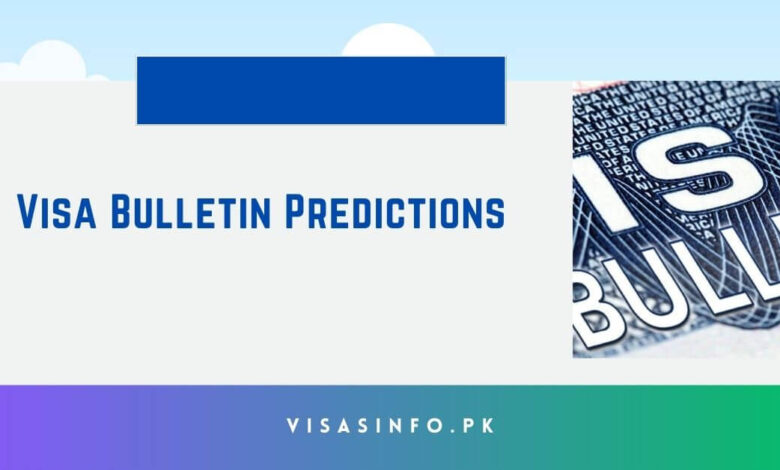Visa Bulletin Predictions 2024 – Check Here

The 2024 Visa Bulletin is an indispensable resource for individuals who aspire to enter the United States. It provides information on the availability of immigrant visas and the dates of priority. This blog will provide a comprehensive analysis of the Visa bulletin for 2024 and offer speculation regarding its contents.
It will address potential changes to the Visa processing timelines, priority dates, and visa categories. After reading this blog, readers should have a better understanding of what to expect from the Visa Bulletin for 2024.
Visa Bulletin February 2024 Predictions
The visa application procedure is eagerly anticipated by millions of individuals in the family- and employment-based categories. The Visa Bulletin’s predictions provide valuable information regarding the application and acquisition of green cards.
The State Department has recently released the Visa Bulletin for January 2024, which contains critical information regarding visas for the fiscal year 2024. The government predicts that the number of green cards accessible for individuals in employment categories will decrease from 197,000 in 2023 to 165,000. Nevertheless, this exceeds the legal minimum of $140,000 by $25,000.
Due to the 25,000 family-based green cards that were not utilized in 2023, the State Department’s Visa Bulletin for January 2024 underscores the significant delays in the acquisition of green cards for employment and family-based categories. The length of time it takes to obtain a green card is contingent upon the category of your petition and your country of birth. Visa Bulletin undergoes monthly updates, which is noteworthy.
Visa Bulletin for February 2024
The forecasts for the Visa Bulletin February 2024 are divided into the following subtopics: Visa Bulletin February predictions (based on family categories) and Visa Bulletin February predictions (based on employment categories).
Family-Based Categories Visa Bulletin Prediction for February 2024
The most recent changes in the family-oriented categories are the basis for the projected Visa Bulletin estimates. Please be advised that these are not intended to serve as legal advice. These projections illustrate the potential for the final action dates for visas to either advance or regress in the upcoming month.
F1 (Unmarried adult sons and daughters of US citizens)
- Mexico: One to two weeks
- Philippines: three to four weeks
- All other countries: 4 to 5 weeks
F2A (LPRs’ spouses and minor unmarried sons and daughters)
- Mexico: One to two weeks
- All other countries: two to three weeks
F2B (Unmarried adult sons and daughters of LPRs)
- Mexico: 2-3 weeks
- Philippines: three to four weeks
1-2 weeks for all other countries
F3 (mature sons and daughters of US citizens who are married)
Mexico: One to two weeks
- Philippines: 2 to 3 weeks
- 1-2 weeks for all other countries
F4 (brothers and sisters of US citizens)
- Mexico: 2-3 weeks
- India: 2 to 3 weeks
- Philippines: three to four weeks
- 2 to 3 weeks for all other countries
Employment-Based Categories Visa Bulletin Prediction for February 2024
The forecasts for the Visa Bulletin that follow are computed estimates that are based on the most recent developments in the employment-based categories. It is crucial to bear in mind that these are not intended to serve as legal advice.
EB1 (Priority Workers)
- India: 2 to 3 weeks
- China: One to two weeks
- Every other nation remains current.
EB2 (individuals with exceptional abilities or members of the professions who possess advanced degrees)
- India: One to two weeks
- China: 2 to 3 weeks
- All other countries: 3 to 4 weeks
EB3 (skilled laborers and professionals)
- India: 2 to 3 weeks
- China: three to four weeks
- All other countries: 3 to 4 weeks
The 7% Per Country Cap
The country quota is a critical element of the family and employment preference categories, as it limits the number of immigrants from a particular country who are eligible to receive green cards in a given year. Not more than 7% of all EB and FB preference visas may be obtained by any nation in a given year. Nevertheless, there are no country-specific restrictions that apply to the immediate relatives of US citizens.
The numerical and country-specific limitations have resulted in extended waiting periods for specific Green Card categories, which primarily impact a small number of nations. For example, in the majority of the world, US citizens are required to wait over 15 years before sponsoring their siblings. Nevertheless, the offshore waiting period for siblings from Mexico is over 22 years, while it is 20 years for those from the Philippines.
Although hundreds of thousands of individuals are awaiting green cards sponsored by their employers, millions of individuals are patiently waiting for green cards sponsored by their families. At present, a significant number of these individuals reside in the United States and possess transitory work permits. Regrettably, the legal immigration status of their children is at risk of being compromised once they reach the age of 21, which increases the likelihood of their separation from their families.
Check Also: Australia Visa Processing Update
Benefits of Visa Bulletin Predictions
- Visa Bulletin: Planning and Preparation Predictions assist applicants and their families in better planning their lives by estimating the potential eligibility to advance with their green card applications. This enables them to organize their finances, prepare the requisite documents, and make well-informed decisions regarding their future.
- Informed Decision-Making: By comprehending the probable movement of priority dates, applicants can make strategic decisions regarding their immigration options, including whether to pursue alternative visa categories, apply for extensions, or investigate alternative pathways.
- Reduction of Anxiety and Uncertainty: The immigration process can be particularly distressing when one is awaiting a green card. Predictions can provide a more precise timeline, which can alleviate the ambiguity associated with not knowing when your priority date will become current.
- Legal Strategy Optimization: These predictions can be employed by immigration attorneys and consultants to provide their clients with more informed advice, thereby enabling them to capitalize on their opportunities and circumvent potential obstacles.
- Employer Planning: Employers can more effectively manage their workforce planning by utilizing predictions for employment-based visa categories. This ensures that they can retain critical talent by understanding when their employees may be eligible for green cards..
- Financial Planning: By anticipating the date on which a priority date is likely to become current, applicants can budget for the financial expenses that will be incurred during the subsequent stages of the application process, including filing fees, medical examinations, and travel arrangements.
- Flexibility in Personal and Professional Life: By anticipating the potential receipt of their green card, applicants can more effectively strategize regarding their professional advancements, educational pursuits, or familial decisions, including the acquisition of a residence or the establishment of a family.
- Maximizing Time with Temporary Status: Individuals who are on temporary visas can optimize their current status by anticipating the receipt of their green card, which enables them to capitalize on work opportunities, travel, or other advantages that are associated with their temporary visa.
- Strategic Filing for Family Members: Families can minimize separation periods or ensure that all family members can progress through the immigration process together by determining the optimal time to register for dependent visas based on predictions.
- Advocacy and Policy Influence: Predictions can be used to support policy changes or reforms by those involved in immigration advocacy. This is achieved by emphasizing trends in visa availability and wait times, which in turn influence decision-makers.
Frequently Asked Questions:
-
When can I expect my visa bulletin?
The Department of State issues the visa bulletin every month. Based on the original filing date of the I-130 petition, it indicates which green card applications can proceed.
-
Is the Visa Bulletin accurate?
Archived Visa Bulletins: We have made every effort to ensure the accuracy of these online versions, which are solely for informational purposes.
-
Does the visa bulletin change every month?
The Department of State publishes a monthly Visa Bulletin, which lists the cut-off dates that govern visa availability. As a result, the monthly Visa Bulletin determines which applicants are eligible to file for status adjustment, as well as which applicants are eligible for permanent resident status.



